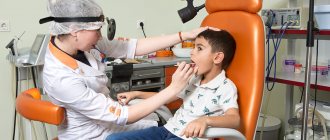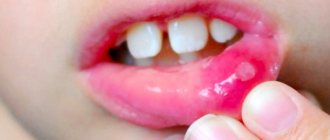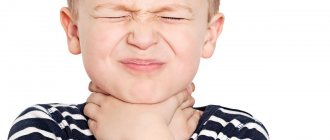Mumps (mumps, behind the ears) is a contagious acute infectious disease of viral origin, in which the salivary glands behind the ears become inflamed in a child. Thus, when mumps occurs in children, treatment must be strictly carried out under the supervision of a doctor. At the SANMEDEXPERT clinic, the pediatrician will examine the little patient, tell you what medications should be taken and how to avoid complications.
This disease is called so because the child’s cheeks seem to puff out, and the little patient becomes like a pig. At risk are young unvaccinated children under seven years of age, most often boys. An adult suffers from the disease much worse than children.
Infants rarely suffer from a disease such as mumps - breast milk provides them with treatment and a kind of immunity from the disease; This immunity lasts up to 5 years. The peak of disease activity occurs in early spring (March, April).
The main cause of the disease is considered to be contact with a sick person, therefore most often they become infected through airborne droplets, but there are often cases when the disease affects a person through contaminated objects.
If a person has been ill with a disease such as mumps, the treatment has been completed, then he will never get sick again.
Types of tracheitis
There are several classifications of this disease:
- according to duration, tracheitis is divided into acute and chronic, the latter most often occurs with periods of exacerbation and remission;
- according to its etiology (reason), it can be infectious or non-infectious;
- Based on the nature of changes in the mucous membrane, they distinguish between catarrhal (when the surface layer of the mucous membrane becomes inflamed), hyperplastic (when the mucous membrane becomes inflamed and thickens) and atrophic tracheitis (when the mucous membrane becomes thinner and loses a significant number of cells capable of performing its functions).
The approach to its treatment depends on the type of disease.
Infection is the main cause of tracheitis
In most cases, tracheitis is infectious in nature. The cause of inflammation of the mucous membrane is viruses and bacteria; associations of different pathogens are possible, that is, the presence of both a viral and bacterial infection at the same time. During the ARVI season, tracheitis in a child occurs as a result of infection with influenza viruses and other types of viruses, the number of which is very large. Subsequently, the addition of a secondary bacterial infection (streptococcal, staphylococcal, etc.) is often noted.
What are the reasons?
Among the infections that can cause mesadenitis in a child are bacteria such as:
- coli;
- staphylococci;
- streptococci;
- salmonella;
- Mycobacterium tuberculosis.
These may also be the following viruses:
- enterovirus;
- adenovirus;
- Epstein-Barr virus;
- cytomegalovirus.
Doctors often associate the development of mesadenitis in children with the presence of diseases such as:
- pneumonia;
- flu;
- Infectious mononucleosis;
- tonsillitis;
- bronchitis.
After severe infectious diseases, a child is often diagnosed with reactive mesadenitis. In addition, this pathology often occurs in children as a specific reaction to vaccinations or uncontrolled use of certain types of medications.
What else can cause tracheitis?
Tracheitis in a child can also be non-infectious in nature. Its appearance is sometimes provoked by foreign bodies in the respiratory tract and medical manipulations during anesthesia affecting the trachea. A common cause of tracheitis is the child inhaling icy or dry hot air, chemically active fumes (from household and industrial chemicals, reagents, paints and varnishes). Continued contact with irritating aggressive substances maintains chronic inflammation. Another possible cause of non-infectious tracheitis in a child is allergies. Inhalation of an allergen triggers a hypersensitivity reaction, which leads to swelling of the mucous membrane of the larynx, trachea and bronchi.
What is adenovirus infection?
Having found out that adenoviral infection is a type of acute respiratory viral infection, we should consider it in more detail.
The main portal of infection is the upper respiratory tract, and less commonly the conjunctiva of the eyes. It has been noted that the virus multiplies at tremendous speed, easily penetrates the blood from the affected area and spreads further throughout the body. In addition to blood vessels, adenoviruses can use lymph nodes and lymphatic tracts as a road.
The causative agent is a virus containing a DNA molecule. The infection lingers on the mucous membranes of the respiratory system and descends below, affecting the intestines. Quite often, lymphoid tissue is infected. The conjunctiva of the eyes also suggests that adenoviruses may be the culprit2.
Predisposing factors
The development of tracheitis is promoted by:
- general hypothermia;
- decreased immunity;
- lack of vitamins;
- rickets in a child;
- impaired nasal breathing (with chronic runny nose, severe curvature of the nasal septum, adenoids);
- tendency to allergic reactions;
- long-term use of inhalers with glucocorticosteroids (hormonal anti-inflammatory drugs), which is sometimes necessary in the treatment of bronchial asthma;
- living in an area with unfavorable environmental conditions;
- presence of a smoker in the family.
All this does not cause clinically significant inflammation of the tracheal wall, but disrupts its barrier function and facilitates the penetration of pathogens.
Symptoms of tracheitis
- Cough.
- Pain in the trachea (behind the sternum), discomfort when inhaling.
- Sleep disturbances in a child, which with tracheitis is associated with coughing attacks.
- Hoarse breathing.
- General weakness, loss of appetite.
- Increased body temperature - from subfebrile (37–37.5°C) to fever (38–39°C). But this is not a mandatory symptom of tracheitis and rather refers to signs of a primary infection.
Any of these manifestations is a reason to consult a doctor.
Symptoms of adenoviral infection in children and their frequency of manifestation
Once in the child’s body, the virus enters the stage of the incubation period, that is, maturation. For 4 to 14 days, more often 5-7 days, the child may not show any signs of the disease. The disease manifests itself acutely or increases gradually.
External symptoms that any doctor can identify include2:
- Copious mucous discharge from the nose;
- Flushing of the pharynx or redness of the mouth;
- Swelling of the tongue;
- Development of pharyngitis;
- Change in the appearance of the tonsils;
- Red eyes and conjunctivitis;
- Increasing intoxication of the body - lethargy, weakness, headache, loss of appetite and nausea;
- Diarrhea, especially in young children;
- Temperature rises to 38–38.5° C.
After many years of studying various manifestations of acute respiratory viral infections, including adenovirus infection, doctors have deduced the frequency of occurrence of certain symptoms, which may indicate a specific virus.
- The most common symptom is fever, which occurs in 96% of cases.
- In 88% of cases with adenovirus infection, pharyngitis develops, and its duration is on average 5 days.
- Cough occurs in 78% of children with adenovirus. The likelihood of a dry and wet cough is approximately the same.
- In 67% of cases, rhinitis with mucous discharge from the nose is observed.
- Enlargement of the cervical lymph nodes is observed in 60% of patients.
- When listening to the lungs, wheezing is detected in 36% of cases.
- In 28% of children, there is a slight enlargement of the tonsils.
- A third may experience complications. The inflammatory process can develop into bronchitis, laryngotracheitis and pneumonia.
- Conjunctivitis is quite rare, but a clear sign of adenovirus infection, which occurs in every fifth person.
- Intestinal disorders have been reported in 22% of children, with a clear predominance in early childhood, in newborns and up to three years of age3.
Parents should pay attention to three stages of symptoms in their child, which are listed in the memo below. After the first segment, you need to seek medical help:
- The first manifestations of adenoviral infection. The child developed a fever, stopped being active, and began complaining of headaches.
- Distribution to all respiratory organs. Coughing, wheezing, sore throat appear, shortness of breath, runny nose occurs, and the child’s voice changes.
- Further progression of the disease. The eyes turn red, and the mucous membrane becomes inflamed (conjunctivitis), and gastrointestinal problems, diarrhea and vomiting may begin.
The following forms are distinguished according to severity:
- A mild form of the disease involves mild symptoms and a slight increase in temperature. In most cases, the disease subsides within a week.
- The moderate-severe form is characterized by severe symptoms of intoxication, fever and chills. The temperature reaches 38° C or more, the disease lasts a long time and complications are possible.
- In severe cases of the disease, the child’s body is subjected to a serious test. The disease almost always leads to complications - bronchitis develops, the liver can increase in size. With this type of disease, hospital treatment will likely be required.
Features of cough with tracheitis
Cough is a key symptom of tracheitis in a child. It is intrusive, often annoying, painful, with a rough, deep sound tint. A cough with tracheitis in a child may be unproductive (dry) or accompanied by the release of viscous, light sputum. Its color depends on the nature and cause of the inflammatory process. With bacterial tracheitis, the sputum released during coughing is usually greenish, and with viral tracheitis, it is white-gray and scanty. Coughing attacks with tracheitis often appear in the early morning hours and immediately after waking up. This is explained by physiological stagnation of blood in the child and weakening of drainage (release of sputum) of the respiratory tract during prolonged lying down. Swelling and accumulating mucus provoke a coughing attack.
Treatment of tracheitis in children
Treatment of tracheitis in a child should be carried out under the supervision of a pediatrician. In severe cases, you may need the help of a pulmonologist - a doctor who treats diseases of the lungs and respiratory tract. Treatment of tracheitis includes medicinal and non-medicinal methods, the right combination of which can alleviate the child’s condition and cope with cough.
Medication methods
- To influence the infectious cause of the disease, antibacterial, antiviral or antifungal agents are prescribed. But with mild tracheitis, the doctor may decide to treat without the use of such drugs. In this case, the child will be under constant observation; if the condition worsens, the therapy will be adjusted.
- The main efforts in the treatment of tracheitis are aimed at relieving cough. For this, the child is prescribed mucolytics, which help thin and remove mucus. Antitussives for tracheitis are indicated in cases of debilitating cough. They are used strictly as prescribed by a doctor.
- When treating a child, cough remedies containing extracts of medicinal plants with mucolytic, expectorant and anti-inflammatory effects are also widely used. The components included in the composition complement and enhance each other's action. For example, Doctor MOM® cough syrup contains 10 carefully selected medicinal plant extracts. It helps to liquefy and remove mucus during tracheitis, and has an anti-inflammatory effect. Doctor MOM® cough syrup can be used to treat children from 3 years of age.
Non-drug methods
In addition to drug therapy for tracheitis, various physical procedures are used, a special massage to facilitate the discharge of sputum when coughing - all according to the doctor’s indications. It is important to remember that timely initiation of comprehensive treatment and compliance with the recommendations of a specialist is the key to successfully ridding a child of tracheitis. Self-medication of cough is fraught with the development of complications and a protracted course of the disease.
Diagnosis of gingivitis
The diagnosis should be made by a doctor in a dental clinic; only through a visual examination will he be able to determine the status of the disease and differentiate it from many others, which at an early stage may manifest the same symptoms.
The main clinical signs by which a dentist can make a diagnosis are:
- the presence of erythematous formations at the gum edge;
- looseness, separation of soft tissues from the dentition, the appearance of pockets larger than 3 mm;
- when pressed with a dental spatula, exudative and bloody discharge is observed, in some cases with a putrid odor;
- obtaining the result of smears to determine the pathogen.
The last point is one of the most important in making a diagnosis and prescribing adequate procedures. Depending on the type of bacteria that caused the disease, various antibiotics and antiseptics can be used to speed up recovery. Also, after collecting an anamnesis, based on diagnostic results, the doctor needs to identify the root cause in order to further prevent the risk of relapse.











